|
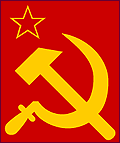 After
almost twenty years of hardship from the Five Year Plans,
the purges, and World War II, the Soviet
people were hoping for a freer, more prosperous life. But
those hopes were quickly dashed as the Cold War began. After
almost twenty years of hardship from the Five Year Plans,
the purges, and World War II, the Soviet
people were hoping for a freer, more prosperous life. But
those hopes were quickly dashed as the Cold War began.
Stalin launched a fourth Five-Year
Plan in 1946 to bring a quick recovery from the wartime destruction,
and announced that austerity, hard work, and rigid discipline
would continue for some time to come. He pointed out that
the ultimate enemy of the Soviet Union, capitalism, was still
around, and that "so as capitalism existed, the world
would not be free from the threat of war." Therefore
Soviet citizens would have to be ready for yet more sacrifices
and dangers.
|

|
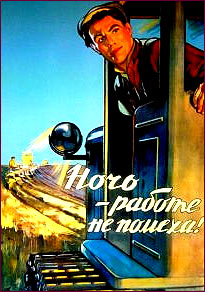 Always
preoccupied with security, Stalin spent the postwar years further
strengthening his control over the country. He was so thorough
at this, in fact, that the years 1945-53 are the most repressive
in Soviet history. Western art, literature, clothing and lifestyles
(even jazz) were banned, and foreign tourists were not allowed
to visit the USSR until 1958. During and immediately after the
war 1,250,000 people from seven ethnic groups of dubious loyalty
(Volga Germans, Crimean Tatars, Kalmucks, and four smaller minorities
from the Caucasus) were accused of collaboration with the Nazis
and deported to Central Asia and Siberia. Always
preoccupied with security, Stalin spent the postwar years further
strengthening his control over the country. He was so thorough
at this, in fact, that the years 1945-53 are the most repressive
in Soviet history. Western art, literature, clothing and lifestyles
(even jazz) were banned, and foreign tourists were not allowed
to visit the USSR until 1958. During and immediately after the
war 1,250,000 people from seven ethnic groups of dubious loyalty
(Volga Germans, Crimean Tatars, Kalmucks, and four smaller minorities
from the Caucasus) were accused of collaboration with the Nazis
and deported to Central Asia and Siberia.
|
|
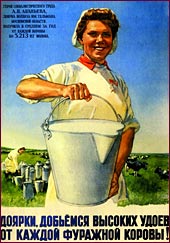 The
unruly Ukrainians were next on Stalin's blacklist, but even
he had to concede that there were not enough trains in the
USSR to get rid of all 40 million of them. Stalinist rule
was toughest in those areas that had just come under Soviet
rule since 1939, and the Catholics living in those areas were
regarded as untrustworthy and forced to join the Orthodox
Church. This resulted in a strange spectacle as the officially
atheistic Soviet state threw its powers of coercion behind
the Orthodox clergy. The
unruly Ukrainians were next on Stalin's blacklist, but even
he had to concede that there were not enough trains in the
USSR to get rid of all 40 million of them. Stalinist rule
was toughest in those areas that had just come under Soviet
rule since 1939, and the Catholics living in those areas were
regarded as untrustworthy and forced to join the Orthodox
Church. This resulted in a strange spectacle as the officially
atheistic Soviet state threw its powers of coercion behind
the Orthodox clergy.
At the same time came new episodes of anti-Semitism.
Officially it was justified on the grounds that many Jews
in the Red Army had defected to the West from East Germany,
and Stalin suspected that Soviet Jews were sending military
secrets to their relatives in the United States. But little
actual persecution took place until the establishment of the
state of Israel in 1948. This was because many Israelis were
socialists and/or immigrants from the USSR, giving Stalin
some hope that Israel would join the Soviet Bloc after independence;
the USSR even voted for the 1947 UN mandate that created the
Jewish state. But because Israel is a parliamentary democracy,
the Israelis have preferred to ally themselves with the West
almost from the beginning. The final blow came when the first
Israeli ambassador to the Soviet Union, Golda Meir, came to
Moscow and received an enthusiastic welcome from Soviet Jews
that made Stalin intensely jealous. Jewish organizations were
suppressed by the state, and Jews in the Communist Party were
removed from their posts. To avoid comparisons with the pogroms
of the tsars, Stalin called this campaign "anti-Zionism."
|
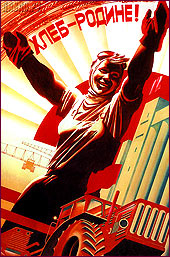 In
February 1953, nine doctors, most of them Jewish, were accused
of poisoning Andrei A. Zhdanov (the Leningrad party chief and
Stalin's favorite minister from 1934 to 1948), and of plotting
to do in other generals and Politburo members. During the previous
year Stalin called his henchmen spies, and Molotov lost his
position as foreign minister because of his Jewish wife; she
was sent to a labor camp without her husband even protesting.
Alleged "Titoists" and "Zionists" were already
being arrested andput on trial in eastern Europe. A new wave
of purges, especially an anti-Jewish one, appeared to be beginning,
and plans were made to deport all Soviet Jews to an autonomous
region set aside for them on the border of Manchuria. But fate
intervened; Stalin died of a cerebral hemorrhage on March 5,
1953. The politburo quickly released the victims of "the
Doctor's Plot." In
February 1953, nine doctors, most of them Jewish, were accused
of poisoning Andrei A. Zhdanov (the Leningrad party chief and
Stalin's favorite minister from 1934 to 1948), and of plotting
to do in other generals and Politburo members. During the previous
year Stalin called his henchmen spies, and Molotov lost his
position as foreign minister because of his Jewish wife; she
was sent to a labor camp without her husband even protesting.
Alleged "Titoists" and "Zionists" were already
being arrested andput on trial in eastern Europe. A new wave
of purges, especially an anti-Jewish one, appeared to be beginning,
and plans were made to deport all Soviet Jews to an autonomous
region set aside for them on the border of Manchuria. But fate
intervened; Stalin died of a cerebral hemorrhage on March 5,
1953. The politburo quickly released the victims of "the
Doctor's Plot."

|
|
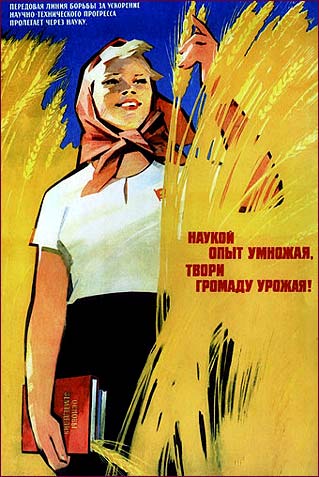
|

|
In 1970s, Leonid Brezhnev, as general
secretary of the Communist party of the Soviet Union (CPSU),
had become the next prominent Soviet leader.
Decades of imperfect one-man rule convinced the Kremlin
that no Soviet leader should be allowed to wield as much power
as Stalin and Khrushchev did, so the Politburo gave the positions
of premier and secretary-general to two different members, Alexei
N. Kosygin and Leonid I. Brezhnev. The arrangement worked for
most of the 60s, with Kosygin running the government and Brezhnev
running the Party; during this time Kosygin was the more visible
of the two because of his trips abroad. But Russia's political
traditions, shaped by a psychological need for a single strong
father figure, gradually reasserted themselves. By 1970 the
technocratic Kosygin had been pushed out of the limelight by
the party man, Brezhnev.
There were many changes in domestic policies under Brezhnev
& Kosygin, but Soviet foreign policy remained pretty much
the same.
Brezhnev's tenure was marked by a determined emphasis
on domestic stability and an aggressive foreign policy. The
country entered a decade-long period of stagnation, its rigid
economy slowly deteriorating and its political climate becoming
increasingly pessimistic.
Seventies are generally known as the years of stagnant stability
in the USSR.
If the Soviet economy stagnated under Brezhnev, the armed
forces never had to go hungry. Every year the defense budget
increased; indeed, it has been estimated that the amount spent
on defense, space, and nuclear energy may have been as high
as 20-25% of the GNP. Since most of the manned and unmanned
space missions carried military payloads of one sort or another,
the space program also got everything it wanted.(17) By 1968
the Soviet nuclear arsenal had grown to match that of the United
States, but the buildup continued without interruption, until
the Soviet Union had the largest war machine in history.
When Breshnev died in 1982 he was succeeded as general
secretary first by Yuri
Andropov, head of the KGB, and then
by Konstantin Chernenko, neither of whom managed to survive
long enough to effect significant changes. In March of 1985,
when Mikhail Gorbachev became
general secretary, the need for reforms was pressing.
|
|



